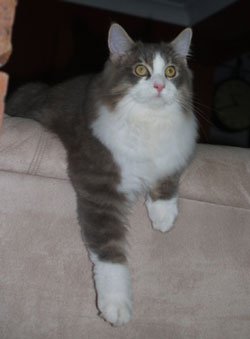Companion

The domestic cat (Felis catus or Felis silvestris catus) is a small, usually furry, domesticated, carnivorous mammal. It is often called the housecat when kept as an indoor pet, or simply the cat when there is no need to distinguish it from other felids and felines. Cats are valued by humans for companionship.
Cats are similar in anatomy to the other felids, with strong, flexible bodies, quick reflexes, sharp retractable claws, and teeth adapted to killing small prey. Cat senses fit a crepuscular and predatory ecological niche. Cats can hear sounds too faint or too high in frequency for human ears, such as those made by mice and other small game. They can see in near darkness. Like most mammals, cats have poorer colour vision and a better sense of smell than humans.
Despite being solitary hunters, cats are a social species, and cat communication includes the use of a variety of vocalizations (meowing, purring, trilling, hissing, growling and grunting) as well as pheromones and types of cat–specific body language.
Since cats were cult animals in ancient Egypt, they were commonly believed to have been domesticated there, but there may have been instances of domestication as early as the Neolithic.
A genetic study in 2007 revealed that domestic cats have descended from African wildcats (Felis silvestris lybica) c. 8000 BCE, in the Middle East. According to Scientific American cats are the most popular pet in the world, and now found almost every place where people live.
The Australian Cat Federation Inc standard for the companion cat can be found here.
